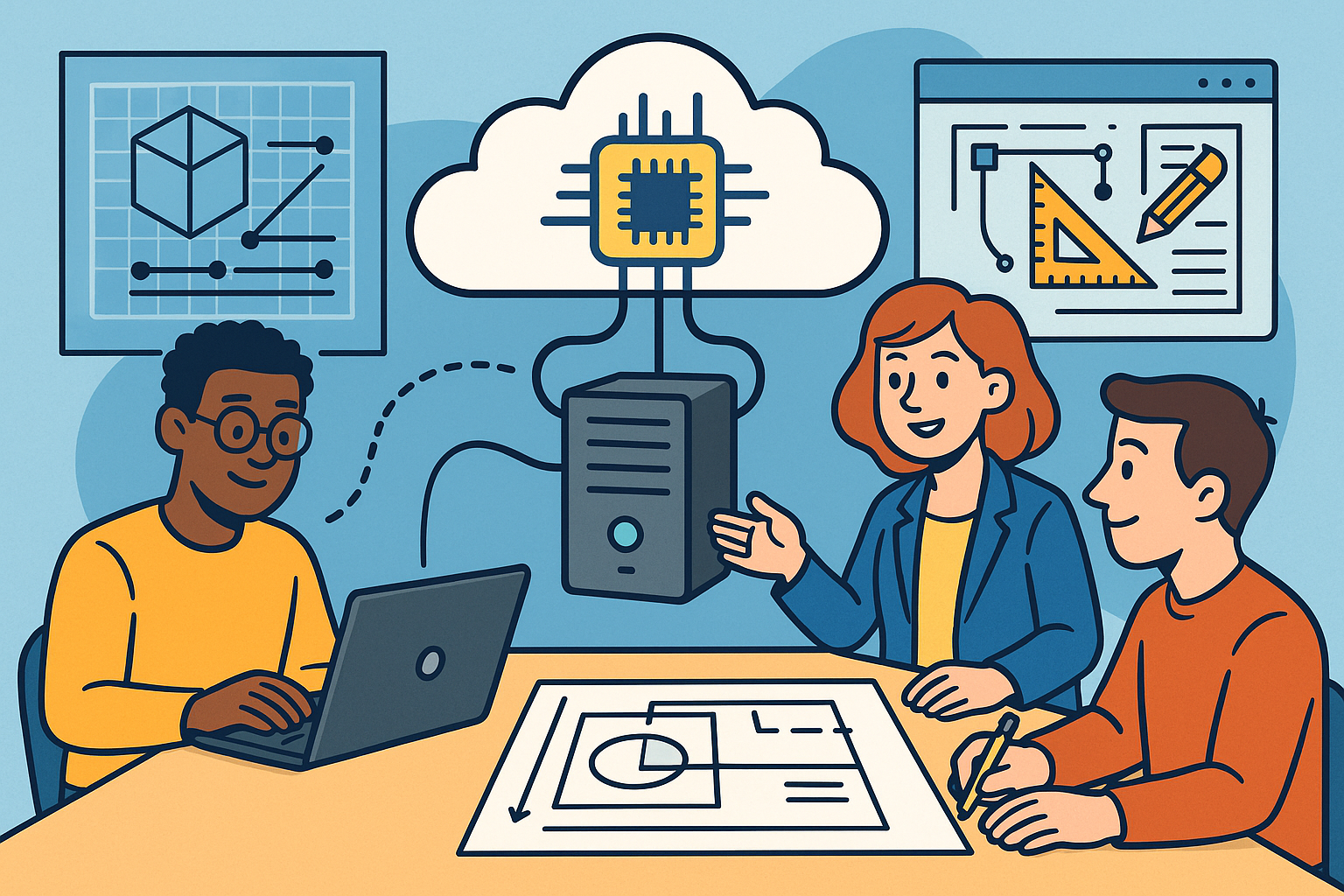Your Cart is Empty
Customer Testimonials
-
"Great customer service. The folks at Novedge were super helpful in navigating a somewhat complicated order including software upgrades and serial numbers in various stages of inactivity. They were friendly and helpful throughout the process.."
Ruben Ruckmark
"Quick & very helpful. We have been using Novedge for years and are very happy with their quick service when we need to make a purchase and excellent support resolving any issues."
Will Woodson
"Scott is the best. He reminds me about subscriptions dates, guides me in the correct direction for updates. He always responds promptly to me. He is literally the reason I continue to work with Novedge and will do so in the future."
Edward Mchugh
"Calvin Lok is “the man”. After my purchase of Sketchup 2021, he called me and provided step-by-step instructions to ease me through difficulties I was having with the setup of my new software."
Mike Borzage
Harnessing Edge Computing for Enhanced Collaborative Design Workflows
August 03, 2025 7 min read


Overview of Edge Computing in Design Collaborations
In today’s rapidly evolving digital landscape, the concept of **edge computing** has emerged as a transformative force in collaborative design environments. This paradigm shift in digital workflows is characterized by the relocation of data processing and analytics closer to the source, thereby reducing latency and greatly enhancing real-time interactions amongst design teams. Edge computing redefines the conventional dynamics of cooperation by ensuring that design data does not have to traverse long distances to remote data centers, enabling faster response times, particularly for applications that demand instantaneous feedback, such as virtual reality visualizations, iterative prototyping, and product simulations. Consequently, design professionals and engineers can collaborate more effectively on complex, data-intensive projects even when geographical constraints are present.
Defining Edge Computing and Its Modern Role
At its core, edge computing represents a distributed computing framework that processes data near the edge of the network, where the data is actually generated, rather than relying solely on centralized cloud infrastructures. The key characteristic of this approach is its ability to handle vast amounts of data rapidly by offloading computation from a single centralized source to multiple localized nodes. What this means for collaborative design is a remarkable improvement in latency reduction. In a design workflow, where multiple designers and engineers may be simultaneously interacting with a shared model or simulation, a delay of even a few milliseconds can lead to misinterpretations or errors in rapid prototyping scenarios. This approach not only optimizes data traffic but also alleviates the pressure on the central cloud infrastructure by distributing the computational load, thereby enhancing overall system performance.
Challenges in Collaborative Design and the Edge Advantage
The dynamic nature of collaborative design has long been hindered by traditional cloud-based processing methods that can introduce unwanted latency, bottlenecks, and potential downtimes. Design professionals often encounter challenges when job processing is centralized in distant data centers, which may impair real-time communication and result in synchronization issues during concurrent design sessions. Edge computing directly addresses these issues by positioning data processing nodes closer to end-users, thereby facilitating **low latency interactions** that are essential in contemporary digital design projects. In addition, this model supports better handling of bandwidth constraints and improves system scalability, which are vital for modern digital design workflows that might involve simultaneous interactions among remote teams. Edge computing thus offers a substantially enhanced framework conducive to higher levels of productivity and more robust collaboration, ensuring that creative innovations remain unhindered by technical delays and network limitations.
Technical Implementation and Integration Strategies
The transformative impact of edge computing on design platforms depends largely on thoughtful technical implementation and seamless integration with existing design ecosystems. From a technical perspective, design software can harness the power of edge computing by deploying distributed computing networks that operate close to the data source. This development demands an intricate architecture composed of localized data processing nodes, specialized hardware accelerators, and APIs engineered to facilitate interoperability between traditional design tools and edge computing frameworks. To ensure smooth integration, several components need to be coordinated in a precise manner, starting from the sensor or user interface level, which collects design inputs, to the computation nodes that process this data in real time.
Localized Data Processing Nodes and Distributed Networks
One of the primary technical implementations in edge computing involves establishing a network of localized data processing nodes strategically placed in proximity to end-user locations. These nodes are responsible for real-time processing, communication, and data storage, which collectively contribute to minimized latency. The deployment of **localized data processing nodes** ensures that the design feedback loop remains uninterrupted, even during intense collaborative sessions. The distributed network is further enhanced by employing hardware accelerators that can handle computation-intensive tasks such as 3D rendering, simulation, and high-fidelity visualization. These accelerators work in tandem with the core processing components to allow for swift transitions between design iterations, thus ensuring that iterative prototyping and real-time feedback maintain their pace. Furthermore, this architectural division makes it possible for industry professionals to benefit from reduced reliance on a single, centralized computing resource, thereby enhancing system resilience and operational continuity.
Integration Strategies for Design Tools and Workflows
Achieving a fully integrated edge computing solution within design platforms requires careful consideration of both hardware and software facets. Key integration strategies typically include utilizing unobtrusive APIs that connect existing design software with the edge infrastructure. These interfaces serve as the bridges between the centralized and decentralized components of the system, ensuring that real-time data processing is seamlessly linked with the conventional design tools used by professionals. Additionally, hardware integration is critical, with the architecture needing to support **hardware accelerators** that are adept at managing complex computational tasks on the fly. The following bullet points delineate crucial aspects of the integration approach:
- Deployment of modular APIs that enable secure, bidirectional data transfers between cloud and edge environments
- Embedding hardware accelerators designed for processing 3D renderings and simulations directly into the endpoint devices
- Utilization of containerized microservices to maintain operational flexibility and ensure quick updates without downtime
- Establishing robust network protocols that support both high-volume data streams and fault-tolerant communication methods
Through these strategies, the system is designed to offer a hybrid working model that leverages the **advanced architectural elements** of both cloud and edge computing. This ensures that design software not only remains compatible with legacy data workflows but also benefits from the high-speed advantages that edge computing environments provide. Designers can thus operate with the confidence that real-time data processing and feedback integrations are managed through the most effective and efficient models available.
Benefits, Use Cases, and Challenges
The application of edge computing in design collaborations brings about a wealth of benefits rooted in its ability to deliver low latency interactions and to provide robust support for real-time feedback in dynamic design environments. One of the primary advantages is how it enhances the workflow of collaborative design by reducing the delay between design modifications and system responses. This proves particularly advantageous in environments where every millisecond counts, for example, in iterative prototyping or rapid visualization of complex 3D models. By processing data locally at the edge, designers are empowered to see changes and receive feedback instantaneously, thus significantly increasing overall productivity. Furthermore, the distributed nature of edge computing ensures that the workload is balanced efficiently across multiple nodes, thereby preventing bottlenecks and enhancing the scaling capability of design platforms.
Advantages for Real-Time Design Feedback and Prototyping
One of the most compelling advantages of edge computing in design collaborations is its capacity to enable **real-time design feedback**. This real-time capability allows teams to make decisions and implement changes on the fly, fostering a more interactive and responsive design process. For instance, in high-stakes design scenarios such as product visualization and architectural modeling, delays in data processing can stifle creativity and hinder progress. Edge computing mitigates these issues by drastically reducing the time required to process large chunks of data. Moreover, with processing happening closer to the source, the inherent risks associated with network congestion and latency are minimized. Designers benefit from a smoother, iterative prototyping process where the impact of each design decision is immediately visible, allowing for both high fidelity and precise adjustments as the project develops.
Operational Challenges and Cybersecurity Concerns
Despite the many advantages, the integration of edge computing into design environments presents several technical and cybersecurity challenges that must be addressed proactively. One of the key hurdles lies in managing the distributed infrastructure. The establishment and maintenance of numerous processing nodes across various geographic locations create challenges in terms of network reliability and data synchronization. To tackle these issues, designers and IT departments must work collaboratively on strategies that ensure that all edge nodes remain up-to-date and operate in unison. Additionally, the distributed nature of the network inherently raises cybersecurity concerns. Each localized node can become a potential target for cyber threats, necessitating robust security protocols, advanced encryption methods, and continuous monitoring. In particular, safeguarding sensitive design data and intellectual property is paramount. To summarize these challenges, consider the following measures:
- Implementing multi-factor authentication across edge nodes to prevent unauthorized access
- Deploying continuous monitoring systems and real-time threat detection algorithms
- Regularly updating firmware and security patches to protect from evolving cyber threats
- Ensuring end-to-end encryption for data traveling between localized nodes and central servers
By carefully addressing these challenges, the industry can harness the transformative power of edge computing without compromising on security or operational efficiency. The continual development of cybersecurity frameworks tailored for distributed environments will be essential in overcoming potential vulnerabilities.
Conclusion
In conclusion, the integration of edge computing into design collaborations represents a major leap forward in the way digital workflows are managed and optimized. The ability to process data locally through **edge computing architectures** drastically reduces latency, thereby ensuring that real-time feedback and iterative prototyping are executed with remarkable precision. This approach not only enhances team collaboration across diverse locations but also propels the evolution of design tools towards more responsive and interactive platforms. As the digital design landscape continues to grow in complexity, the need for innovative and efficient data processing solutions becomes increasingly apparent.
Future Research and Development
The potential for further advancements in this field is vast. Future research will likely focus on the integration of **artificial intelligence** with edge computing frameworks, driving smarter design systems that can predict user requirements and optimize workflows with minimal human intervention. In addition, the broader adoption of edge computing across various disciplines—from engineering computation to architectural design—signals a significant shift in how data-intensive applications are structured and deployed. As these technologies evolve, the opportunities for scalability and enhanced performance will continue to expand, setting the stage for groundbreaking innovations in real-time collaborative design.
Balancing Innovation with Security and Scalability
However, as with any transformative technology, striking the right balance between innovative implementation and robust security is critical. It is essential that industry professionals continuously refine the methodologies and security protocols surrounding edge computing to protect against potential vulnerabilities. Equally important is the scalability of these systems, which must be designed to accommodate rapid growth in data volume and user engagement without compromising performance. By maintaining a focus on both security and operational resilience, organizations can ensure that their design platforms remain agile, secure, and well-positioned to meet the challenges of tomorrow’s digital landscape.
Also in Design News

Cinema 4D Tip: Efficient Lookdev Iteration Using Cinema 4D Picture Viewer History
January 01, 2026 2 min read
Read More
Revit Tip: Standardized Revit Export for Reliable Navisworks Clash Detection
January 01, 2026 2 min read
Read More
V-Ray Tip: VRayOverrideMtl Clay Pass for Accurate Lighting Evaluation
January 01, 2026 2 min read
Read MoreSubscribe
Sign up to get the latest on sales, new releases and more …


